A WESTERN Sea Change
Expat South Aussie, Tom Treagust, passes on some valuable tips for anyone looking to relocate and tap into a brand new fishery.
I grew up in Largs Bay and when I was four, Dad purchased a boat —a Haines Hunter V17L. As a keen scuba diver, he purchased it with that as his primary intended use, as he wasn’t really a keen fisherman. However, as he had a young fella’ at home who was frothing to get out, he made an effort to learn a bit about fishing and take me out on the water. I remember him ringing up the automated Weather Bureau line to get the day’s forecast before we went out, as the internet wasn’t what it is today. We would then launch from North Haven and head to Semaphore Reef to target tommies and garfish, with the odd squid getting caught on a dead tommy set under a float. On the way in and out we would often put out a paravane to catch a “big” fish, a snook.
When I was about 11, Dad purchased a holiday property in Edithburgh and we started frequenting there, heading over on weekends and during holiday periods. We had a pro fisherman who lived next door and, as dad knew I was keen to start chasing some bigger fish, he asked him for some pointers to try and get me a snapper. We headed out on the day before my 13th birthday and, fishing in the area he suggested, I managed to snag my first snapper, bang on 60cm. I was rapt.

Fast forward a few years and I found myself living in Whyalla after finishing my electrical apprenticeship. I purchased the V17L from Dad when I moved there, as he was living in Alice Springs at the time and didn’t have much use for it. While in Whyalla I spent a lot of time fishing for whiting and squid out from Mount Young and started regularly chasing snapper, somewhat unsuccessfully to begin with. It took me over a year of trying before I managed my first legal one, but once the cherry was popped, I started to find them more and more consistently.
A mate I had met through work who was also a keen fisherman suggested that we take my boat down to Coffin Bay and head offshore to have a crack at tuna. Having only caught tuna once before when on a charter that circumnavigated KI (with the Editor of this magazine), I enthusiastically agreed and we headed down there, launching from Farm Beach and heading to Greenly Island. We got super lucky weather wise, with the swell below a metre and absolutely no wind.
Once out near the island, he got out his divers and skirts, set the spread and started looking for birds. We ended up getting our limit of tuna and I was stoked. Having started with Dad in the shallows catching tommies to now doing 120km-plus trips and getting bluefin tuna from the same 17ft boat, I felt that I had come a long way and learnt a lot. The biggest issue with tuna now becoming a realistic target was that it started an addiction to lures that I think a lot of fishermen can relate to!
It was early in 2018 that I decided to move to Perth, as I had started working in the mining industry in the Pilbara. Dad had, by that point, purchased a Haines Signature 532F, which was a little bit bigger and beamier than the V17L, and he suggested trading boats as he thought the 532F might be better for the open ocean I would be fishing out west. I agreed, so we did the deal, I hooked up my new boat and excitedly headed across the Nullarbor.
The first thing I had to understand was the totally different conditions. With the exception of a couple of trips offshore from Coffin Bay, I had never really had to contend with swell, as Adelaide, Edithburgh and Whyalla are all located in shallow, sandy-bottomed, protected gulfs. Perth is located on the Indian Ocean with a fringing reef running parallel to the coast (known as the 3 Mile Reef) that the powerful ocean swells break over in most conditions. There is also lots of scattered inshore reef that you can easily lose a prop on if you’re not paying attention. It drops off to quite deep water once you
get past the 3 Mile; you’re in 100m-plus of water within about 40km, and the Perth canyon (500m-plus) lies within 53km of my local ramp, which offers a pretty diverse range of fishing options.
Another big change is the relative lack of tidal movement. The Point Lowly rip in Whyalla or Tapley Shoal off Edithburgh can only be effectively fished on a slack tide, such is the water movement. In Perth I have found the tide almost negligible, to the point where I don’t even check it prior to heading out. As an example, an average tide is 700mm of movement over 12 hours.
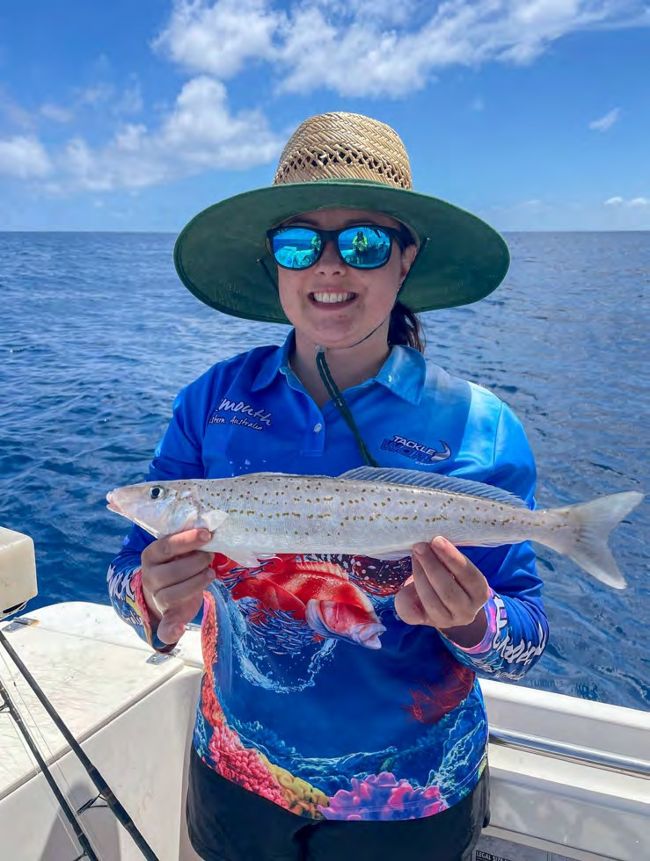
Katie Treagust with a superb WA King Geaorge
Rather than the 8-10 ounce snapper sinkers that were required in Whyalla, I have found the most effective method of catching inshore (25m deep or less and inside the 3 Mile) snapper to be anchoring and berleying on structure and sending out a single unweighted 8/0 circle on 30-40lb leader. Best bait is half a pilchard, a strip of squid or strip of fresh fish fillet. On occasion I might have to incorporate a small ball sinker, but generally speaking, unweighted works best.
One irony is that WA pilchards are a common bait in tackle stores throughout SA and on the east coast, but in WA nobody calls them pilchards. They know them only as mulies, so if you come for a trip, remember that! Another dynamite method is to use extremely light jig heads (TT make 1/6 and 1/8 ounce with heavy duty 6/0 hooks) with a 6-7 inch curly tail grub-style soft plastic, and just let that drift through your berley trail with the rod in the holder, recasting it when it makes it to the bottom. Snapper tend to smash them mid water.
A common by-catch when fishing inshore are samson fish. You’ll know when you hook one because they take off like a stabbed rat, either towards the nearest sharp structure or straight towards the anchor rope. I have had them swim up my berley trail of cubed pilchards right to the boat and then hang around, picking off the cubes one by one, just under the surface. It’s pretty cool to see, but a pain when you’re trying to get a snapper and you keep hooking bloody sambos! Other by-catch includes silver trevally (called skippy in WA), kingfish up to a metre, Western Australian dhufish, harlequin fish, and breaksea cod (known as blackarse). On one occasion I caught some bonito as a school swam through. Snapper are definitely the species most commonly targeted and caught inshore though. My outfit is a 7ft 6-10kg rod paired with a 5000 sized reel and 30lb braid — the same outfit I used when snapper fishing in Whyalla.
Moving past the 3 Mile and heading offshore, the most common demersal target is the Western Australian dhufish. As I built up experience, I found myself heading offshore more and more and further and further to chase them, hoping to get the 20kg beast that everyone dreams about. Thus far my biggest is 10kg, but I’ll keep persisting, as there’s a 20kg one out there with my name on it.
Fishing in deeper water required a better sounder with a more powerful transducer than I had, so after doing some research, I settled on a Simrad EVO 3S and paired it with a transom- mounted 1kw Airmar 275LHW. What a difference this made to my fishing! The returns I was getting and the crispness that the Simrad displayed made me wonder how I had got by without it.
Like all demersals, dhufish hang around structure, which doesn’t have to be a 3m bommie; some of my most successful sessions have come from seeing a small bit of ‘fluff’ on a hard bottom and dropping a bait or a soft plastic down and holding on as the rod buckles. Ideally, you’ll see some big arches, but I’ll always drop on anything that looks interesting, whether that is some ‘fluff’, a rise, a hole or some bait. I’ve found the most successful method is finding something interesting on the sounder, putting out a drift anchor and drifting along it a few times.
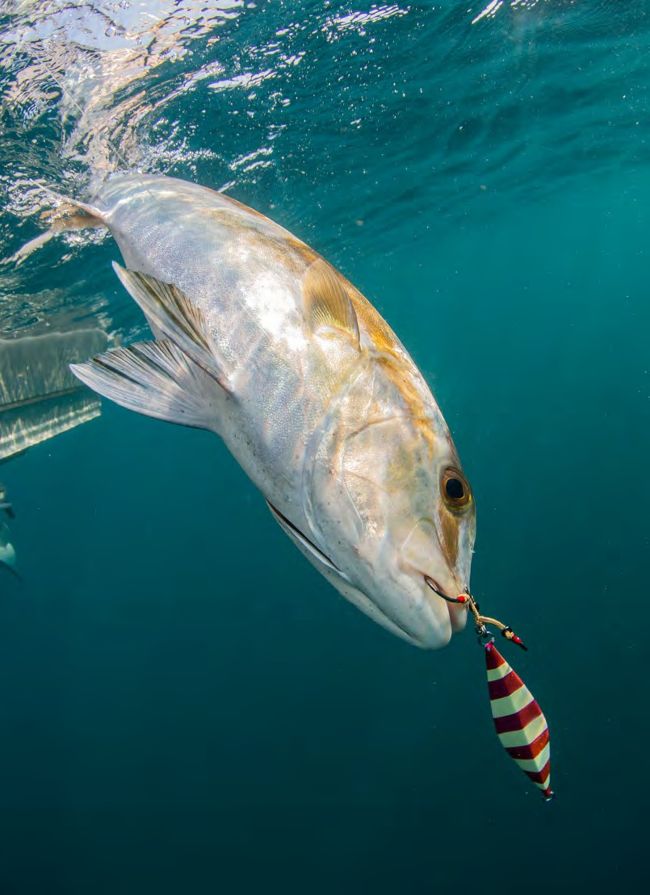
Samsons are always tough guys, regardless of where you catch them
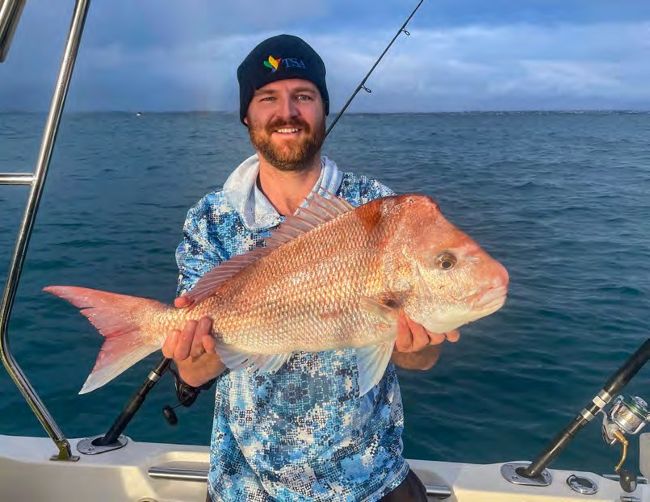
They get plenty of good reds in WA as well
My preferred rig is a simple paternoster with the same 8/0 circles I use inshore tied on 80lb line to offer a bit of forgiveness if it drags across reef. I used to use a double dropper, but recent rule changes now only allow one dropper on your paternoster. Other popular methods of targeting them are using hybrid jigs (basically a lead head of varying weight, depending on depth, with three snelled hooks), slow pitch jigs or big soft plastics with paddle tails. My favorite baits by far are slabs of fresh fish or a big occy tentacle, with squid and pilchard working as well, although quite susceptible to pickers. By-catch offshore is the same as you get inshore, with the addition of baldchin groper, nannygai and the occasional queen snapper. I’ve also caught flathead up to 60cm while targeting dhufish. My most successful depth for dhufish has been between 30-45m, although they can be caught up to about 80m. The outfit I use for offshore demersals is a 6’9”, 20-50lb Shimano Terez paired to a 6000 sized reel spooled with 40lb braid.
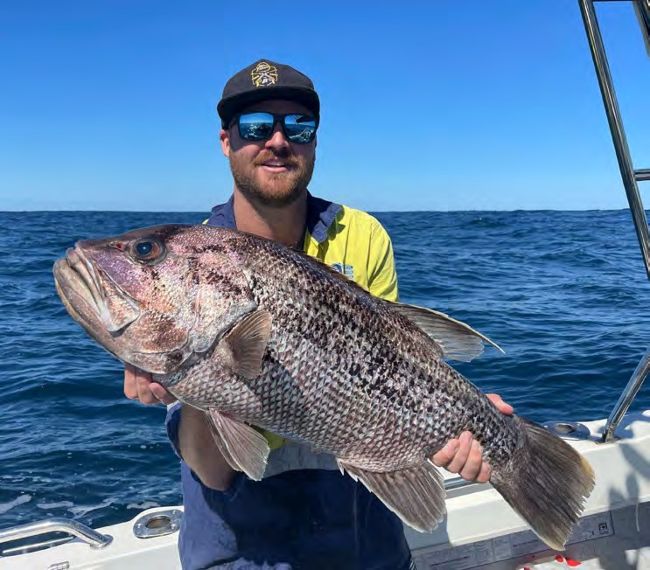
A big dhufish was always top of the bucket list
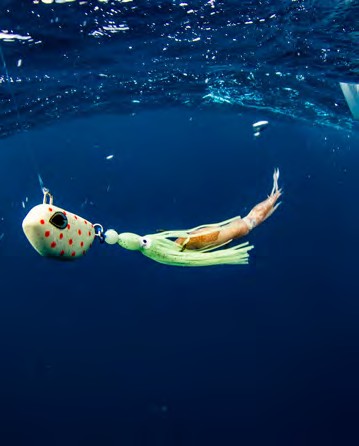
Snapbaits are very popular in WA

Tank McMichan with a WA harlequin
The last big difference I have found is the year-round availability of bluefin tuna from my local ramp. For some reason tuna fishing isn’t really popular in Perth, although with recent tightening of restrictions on dhufish and snapper, more people are beginning to target them. Being able to consistently catch tuna without having to go on a trip has been a game changer for me, as when living in SA, tuna were only an option over the summer months and required towing the boat to places like Coffin bay, Marion Bay or Victor Harbor. Now I just drive 10 minutes to the ramp and pretty much as soon as I’m past the 3 Mile, the lures can go in and more often than not I’ll get a tuna. They aren’t barrels, with sizes usually ranging from 4-10kg. The last two seasons I have caught a good number of yellowfin tuna as well, although I have to travel quite a bit further offshore for them.
The Leeuwin current brings warm water down the coast from up north and the pelagics swim down it chasing the bait. Wahoo, Spanish mackerel and mahi mahi are all realistic targets off Perth in the warmer months, with the wahoo and dollies being caught on the FADS, and the mackerel on the inshore and offshore reefs. Blue marlin have also been caught in the waters behind Rottnest island occasionally. I have found my 40lb offshore demersal outfit to be more than adequate when trolling. Once I started regularly targeting tuna locally, I treated myself to a Shimano Talica 16, which I spooled with 500m of 50lb braid, and use as a dedicated trolling outfit. The diving lures I have personally had the most success with are Nomads in 140mm and 165mm size, and for surface skirts I can’t go past the Pakula UZI’s.
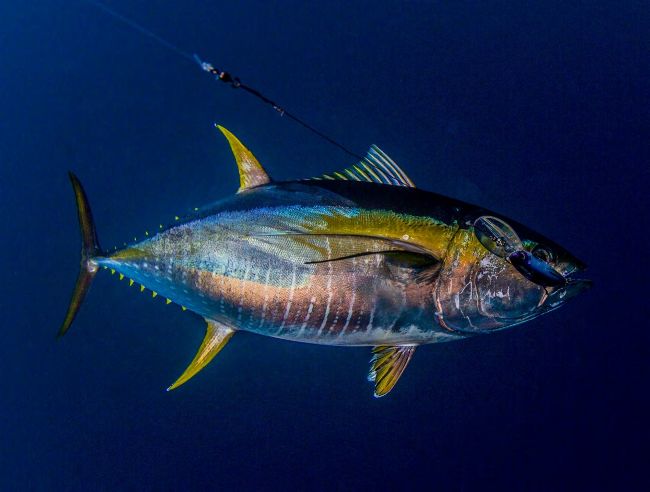
Yellowfin tuna are readily available off Perth
Relocating and having to start from scratch in terms of knowledge of a new area and available species has been a fun journey, and one which is not even close to being over. I found the best starting point when trying to understand my new local to be watching YouTube videos from local anglers, applying their techniques and, through trial and error, seeing what worked for me. Spending as much time as possible actually out on the water having a crack and not being afraid to try new things is important too.
If ever you find yourself relocating and having to start again, be prepared to invest some time before expecting consistent results, but once you figure things out, it’s pretty satisfying. I had to go through it in Whyalla, and then again in Perth, with each time making me a more well-rounded and experienced fisherman. Even if you don’t do something as dramatic as moving interstate, I would encourage you to get out of your comfort zone and try a new technique, target a different species, or fish a new area. Challenge yourself. You won’t be disappointed.
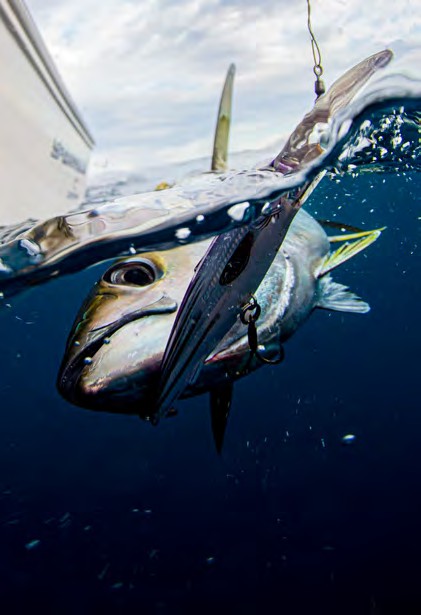
Underwater images by Marco Fraschetti – @oceansdownunder